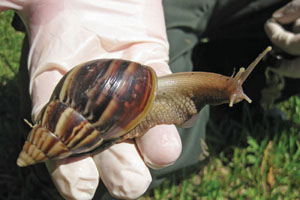Giant African snail invasion a shell of a big problem in US
 |
|
The giant African land snail is one of the most invasive varieties in the world. Provided to China Daily |
No one knows how they got there. But an invasion of African giant snails has southern Florida in a panic over potential crop damage, disease and the general yuckiness surrounding the slimy gastropods.
The United States and Florida departments of agriculture have mobilized 34 agents to battle the infestation and the US Fish and Wildlife Service is heading up an investigation into how the mollusks - which can be up to 20 cm long - arrived.
"This is a big snail - a very big snail," says Suzi Distelberg, a district inspector for the Florida Department of Agriculture, as she probes one of the shells with a gloved hand.
"No it's not empty, see eeew. It's very heavy. You can tell the snail is still in there. We've been told that they like to eat the stucco off the sides of the houses because it contains calcium, and the calcium helps to build their shells."
The Lissachatina fulica, or giant African land snail, can live up to nine years and are prolific, laying up to 1,200 eggs a year, making it extremely invasive. A single snail can create a mass that invades an entire neighborhood.
Local resident Yolando Garcia Burgos one morning discovered snail excrement on her exterior wall and ended up collecting 583 of the mollusks in a week, finding them in her bushes, on her grill and in her ivy. State authorities say they have captured 35,000 since the invasion began in September.
But the concern is not simply a question of aesthetics: The snail's mucus can contain a parasite that transmits a form of meningitis, which is not lethal but can provoke extreme abdominal pain.
The pest is also a threat to agriculture, feasting on some 500 plant varieties, including peanuts and melons.
"If they were to become established, it could devastate Florida's agriculture," says Mark Fagan, of the state agriculture department, who notes agriculture is second only to tourism in the state's economy.
It's not clear how the world's largest snail species arrived in Florida. Originally from eastern Africa, they have also been found in Caribbean islands including Guadeloupe and Martinique.
This is not the first invasion for Florida.
In 1966, a boy imported three giant snails as pets, and his grandmother released them into the wild, which led to a colony of 18,000. The eradication effort took nine years and cost more than $1 million.
Importation of these animals is illegal in the United States without a federal permit. But officials point out they are used in certain Afro-Caribbean religious practices.
Fagan says it's not clear if the snails were brought over for religious ceremonies or as pets and got "out of control".
The eradication effort is in full force, even though the snails are in a sort of hibernation during which they dig themselves into the ground, making them less visible.
Authorities are hoping to bring down the population before the spring, when rains could cause a population surge.
Officials say the areas being cleaned up will remain under scrutiny for several months. Gardens are treated with iron phosphate, which is not harmful to other animals but disrupts the snails' feeding habits.
The captured gastropods are taken to a lab where specialists like Mary Yong examine them and, ultimately, kill them off. The snails are effectively drowned in an alcohol solution or put in a freezer to ensure they are dead.






















